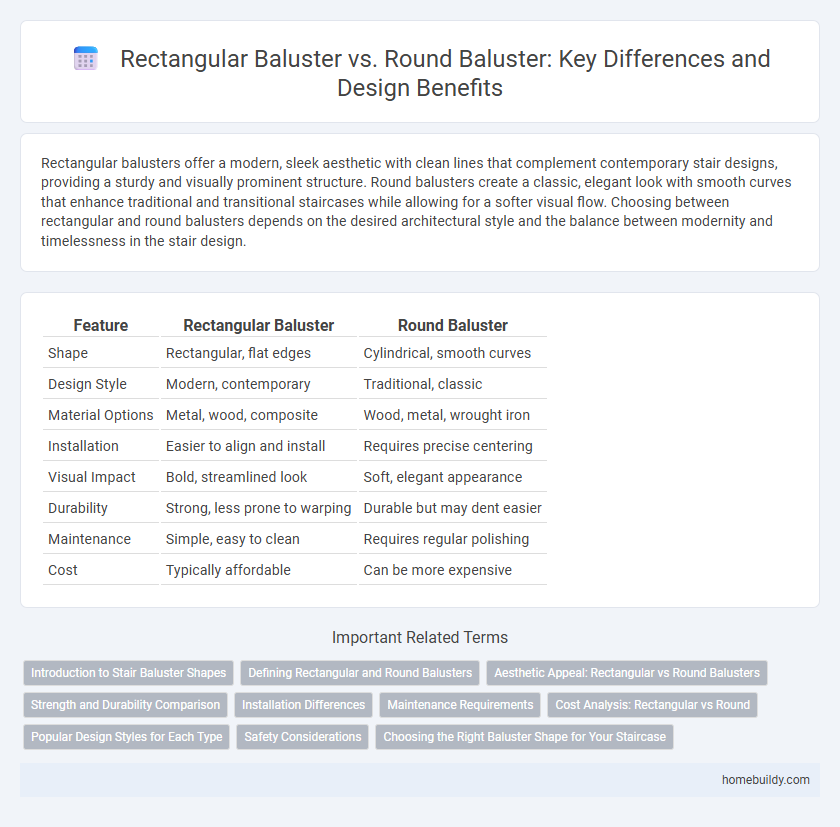Rectangular balusters offer a modern, sleek aesthetic with clean lines that complement contemporary stair designs, providing a sturdy and visually prominent structure. Round balusters create a classic, elegant look with smooth curves that enhance traditional and transitional staircases while allowing for a softer visual flow. Choosing between rectangular and round balusters depends on the desired architectural style and the balance between modernity and timelessness in the stair design.
Table of Comparison
| Feature | Rectangular Baluster | Round Baluster |
|---|---|---|
| Shape | Rectangular, flat edges | Cylindrical, smooth curves |
| Design Style | Modern, contemporary | Traditional, classic |
| Material Options | Metal, wood, composite | Wood, metal, wrought iron |
| Installation | Easier to align and install | Requires precise centering |
| Visual Impact | Bold, streamlined look | Soft, elegant appearance |
| Durability | Strong, less prone to warping | Durable but may dent easier |
| Maintenance | Simple, easy to clean | Requires regular polishing |
| Cost | Typically affordable | Can be more expensive |
Introduction to Stair Baluster Shapes
Rectangular balusters offer a clean, modern aesthetic with sharp lines that complement contemporary stair designs, enhancing architectural precision and structural stability. Round balusters provide a traditional, classic appearance with smooth, cylindrical profiles ideal for creating an elegant, timeless look in staircases. Choosing between rectangular and round stair balusters depends on the desired style, with material options like wood, metal, or composite influencing durability and maintenance.
Defining Rectangular and Round Balusters
Rectangular balusters feature straight, clean lines and sharp edges that create a modern and structured aesthetic, often made from metal, wood, or composite materials. Round balusters, characterized by their cylindrical shape and smooth curves, offer a classic and traditional appearance commonly crafted from wrought iron, wood, or aluminum. Each baluster type influences the overall stair design, with rectangular balusters providing a contemporary look and round balusters delivering timeless elegance.
Aesthetic Appeal: Rectangular vs Round Balusters
Rectangular balusters create a modern, sleek aesthetic with clean lines that complement contemporary architectural styles, while round balusters offer a classic, traditional look that enhances elegance and softness in stair design. The choice between rectangular and round balusters significantly impacts the visual rhythm and style cohesion, where rectangular shapes emphasize linearity and minimalism, and round shapes provide a timeless, sculptural quality. Homeowners seeking a bold, geometric statement often prefer rectangular balusters, whereas those valuing charm and ornate detailing lean towards round balusters.
Strength and Durability Comparison
Rectangular balusters offer increased strength and stability due to their flat surfaces and thicker cross-sectional area, making them ideal for high-traffic staircases. Round balusters, while aesthetically pleasing with smooth curves, generally provide less resistance to lateral forces and may wear down faster over time. Choosing rectangular balusters enhances long-term durability and structural support in stair railing systems.
Installation Differences
Rectangular balusters require precise alignment and uniform spacing for a clean, modern look, often necessitating more exact measurements and cuts during installation compared to round balusters. Round balusters, typically easier to install, fit seamlessly into pre-drilled holes and are more forgiving with spacing variations, making them a preferred choice for quicker or less complex stair projects. Choosing between rectangular and round balusters impacts the installation time, tools needed, and overall precision in achieving a visually balanced stair railing.
Maintenance Requirements
Rectangular balusters typically require less frequent cleaning due to their flat surfaces that resist dust accumulation and are easier to wipe down. Round balusters may demand more regular maintenance as their curved shapes can trap dirt and grime in crevices, necessitating detailed cleaning. Choosing rectangular balusters can reduce time spent on upkeep while maintaining a sleek, modern aesthetic.
Cost Analysis: Rectangular vs Round
Rectangular balusters typically cost less due to simpler manufacturing processes and lower material waste compared to round balusters, which require more precise shaping and finishing techniques. The price difference can range from 10% to 30%, influenced by material type and design complexity. Homeowners aiming for budget-friendly options often prefer rectangular balusters without compromising structural integrity or aesthetic appeal.
Popular Design Styles for Each Type
Rectangular balusters are favored in modern and contemporary design styles for their clean lines and minimalist appeal, often found in metal or wood finishes that complement sleek staircases. Round balusters, commonly used in traditional and classic architectural styles, offer a timeless look with turned or wrought iron designs that add ornamental detail and elegance. Both types enhance stair aesthetics but align distinctly with either crisp, geometric design trends or more ornate, classic motifs.
Safety Considerations
Rectangular balusters provide enhanced safety by offering a more stable grip and reducing the risk of slipping compared to round balusters, which can be harder to grasp firmly. The flat surfaces of rectangular balusters also prevent rotation or wobbling, increasing overall railing stability in staircases. Building codes often emphasize spacing and shape to minimize fall hazards, where rectangular balusters are preferred for their secure and reliable design.
Choosing the Right Baluster Shape for Your Staircase
Rectangular balusters offer a modern, sleek aesthetic with clean lines that complement contemporary staircase designs, while round balusters provide a classic, traditional look with smooth curves ideal for vintage or rustic interiors. Consider the overall architectural style and visual flow of your space when selecting between rectangular and round balusters to enhance staircase harmony and safety. Material and durability factors also influence the choice, as rectangular balusters often suit metal or wood with sharp finishes, whereas round balusters fit well with turned wood or wrought iron craftsmanship.
Rectangular baluster vs Round baluster Infographic

 homebuildy.com
homebuildy.com